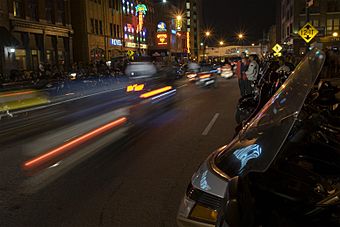Wholesale District, Indianapolis facts for kids
Quick facts for kids |
|
|
Indianapolis Union Station-Wholesale District
|
|

Nightlife along S. Meridian St., Wholesale District, Indianapolis.
|
|
| Location | Roughly bounded by Capitol Ave., Maryland, Delaware and South Sts., Indianapolis, Indiana |
|---|---|
| Area | 30 acres (12 ha) |
| Built | 1863 |
| Architect | Multiple |
| Architectural style | Italianate, Romanesque, Cast Iron Design |
| NRHP reference No. | 82000067 |
| Added to NRHP | July 14, 1982 |
The Wholesale District is a special area in Indianapolis, Indiana. It is one of six "cultural districts" in the city. You can find it in the southern part of Downtown Indianapolis's "Mile Square." This district is home to many exciting places. These include Bankers Life Fieldhouse, Circle Centre Mall, and the famous Soldiers' and Sailors' Monument.
Contents
History of the Wholesale District
Before it became a cultural district, the Wholesale District was a very run-down part of Downtown Indianapolis. Around the early 1900s, Indianapolis had one of the biggest railroad networks in the United States. Hundreds of trains passed through Union Station every day.
Early Businesses and Trade
The streets near the station were full of businesses. There were hotels, warehouses, and shops. "Wholesale" grocers sold fresh food every day. This was before modern grocery stores existed. The district had many such grocers. It also had wholesalers who sold dry goods and finished products.
For example, the House of Crane sold cigars. Its front building is still part of the Circle Centre Mall today. Hanson, VanCamp & Co. sold hardware. Also, South Delaware Street became known as "Commission Row." Farmers brought their produce there. Merchants would then sell the goods for a small fee.
Growth of Indianapolis
The Wholesale District was very important for Indianapolis. It helped the city grow from a small town into a big city. Shoppers no longer had to buy finished goods shipped from Louisville, Kentucky or Cincinnati, Ohio. They could now go to a central place. They could buy the same items at lower "wholesale" prices.
With Union Station nearby, wholesalers could ship goods more cheaply. This made trade much easier. However, the Great Depression in the 1930s badly hurt the area. Many businesses closed down.
Becoming a Historic Place
The district was added to the National Register of Historic Places in 1982. It was named the Indianapolis Union Station-Wholesale District. It was recognized for being a major center for wholesale trade in the past.
Modern Transformation
Since 1995, over $686 million has been invested in the area. This money has helped turn it into one of the city's best places for fun and visitors. Many new businesses have opened. There are more than 35 new shops and restaurants.
Recent additions include Circle Centre Mall, Bankers Life Fieldhouse, and The Residences at CityWay. The historic Omni Severin Hotel has also been restored. The area also has the Hilbert Circle Theatre. This is home to the Indianapolis Symphony Orchestra. The theater had a $2.5 million renovation in 2003.





